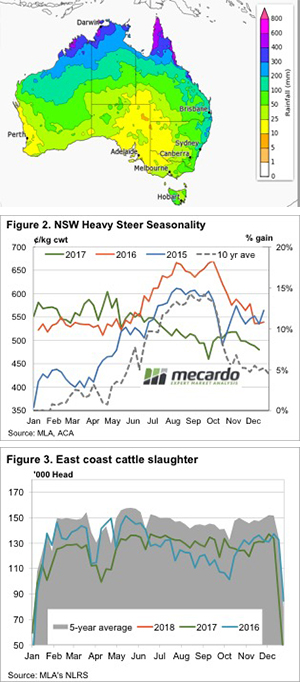A good chance of rain means what for prices?
 A truck driver asked me when we were going to sell some heavy steers that we have wandering around on some still green country. My flippant response was, ‘when it rains in Queensland and the price goes up’. I then thought I’d better do the numbers and make sure this was a better than 50/50 chance of happening.
A truck driver asked me when we were going to sell some heavy steers that we have wandering around on some still green country. My flippant response was, ‘when it rains in Queensland and the price goes up’. I then thought I’d better do the numbers and make sure this was a better than 50/50 chance of happening.
Cattle prices have been waning early in 2018. Little to no rainfall in some key northern cattle areas since before Christmas, cattle supply has opened up relatively strong, and demand from restockers weak.
The latest Bureau of Meteorology (BOM) shows a good chance of above median rainfall over the next three months. But what does this mean? Another map produced by the BOM is shown in figure 1 which gives more of an idea of how much rain an area might expect in February.
Much of Northern NSW and Queensland have a 50% chance of receiving more than 50mm of rain. Even better, there is a 25% chance of most of Queensland getting 100mm or more. The last time we saw good early year rain was in 2015, and figure 2 shows what that did to heavy steer prices.
The situation is a little different now. Back in early 2015 cattle in Australia were heavily under-priced compared to the export market. At the moment cattle prices are close to fair value relative to export prices. However, as we saw this time last year, tight supply can see cattle values well above where export prices suggest they should be.
Whether supply will tighten is a tricky one. We know there is a lot of cattle on feed bolstering finished cattle numbers, but many of these cattle would have been drawn from a pool which is normally finished on grass. Figure 3 shows that spring slaughter in 2017 was higher than 2016, but that could have also been catching up from weak autumn slaughter (figure 3).
It’s hard to see cattle slaughter being any weaker than 2017 in the early part of the year, but it doesn’t need to be to see prices rise. East coast slaughter around 130,000-140,000 head per week should be enough to push prices higher.
Key points:
- The BOM are forecasting a good chance of better than median rainfall in Northern NSW and Queensland from February to April.
- Historically cattle prices track sideways to higher early in the year, with good rains giving a boost to the upside.
- Cattle supply is likely to be stronger than 2017 early this year, but prices could still push higher.
What does this mean?
While rain doesn’t limit the number of heavy slaughter cattle which will come to market, it can see the supply of young cattle and cows tighten, which increases demand for cattle which can fill slaughter space. Hence heavy cattle prices can rise with rainfall.
Without significant rainfall, all cattle prices are likely to continue to drift lower, and consistent supply is net with easing restocker demand. This results in processors facing less competition for all cattle, and lower prices.


